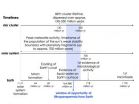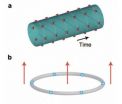(Press-News.org) TEMPE, Ariz. – The idea that drinking red wine may provide health benefits – or possibly even extend your life — is an appealing thought for many people. Now, there may be added attraction. Researchers have found that when given resveratrol, a compound found in red wine, bees consume less food.
Previous scientific studies on resveratrol show that it lengthens the lifespan of diverse organisms ranging from unicellular yeast, to fruit flies and mice. Since bees are social animals like humans, a team of scientists from Arizona State University, the Norwegian University of Life Sciences, and Harvard Medical School, decided to test the effects of the chemical on the honey bee.
In a series of experiments published in the journal Aging, the scientists tested the effects of resveratrol on the lifespan, learning ability, and food perception in honey bees.
Their research has confirmed that not only does this compound extend the lifespan of honey bees by 33 to 38 percent, it also changes the decisions that bees make about food by triggering a "moderation effect" when they eat.
"For the first time, we conducted several tests on the effects of resveratrol by using the honey bee as a model," said Brenda Rascón, an ASU alumnus and doctoral student with Gro Amdam, an associate professor in ASU's School of Life Sciences and the Norwegian University of Life Sciences. "We were able to confirm that under normal living conditions, resveratrol lengthened lifespan in honey bees."
Since resveratrol is an antioxidant, researchers also questioned whether it would be capable of diminishing the damaging effects of "free radicals" — often released during stressful conditions. Free radicals are believed to cause damage to cells, and have an effect on how we age. Resveratrol did not, however, prove to extend the lives of bees living under stressful conditions.
Yet, since the bees tested with the compound were living longer, researchers asked the next question: What's happening that is causing them to live longer?
"Because what we eat is such an important contributor to our physical health, we looked at the bees' sensitivity to sugar and their willingness to consume it," said Amdam. "Bees typically gorge on sugar and while it's the best thing for them, we know that eating too much is not necessarily a good thing."
Interestingly, Amdam, Rascón, and their research team discovered that bees given the compound were less sensitive to sugar. By using different sugar solutions — some very diluted and some with stronger concentrations — they found that bees receiving resveratrol were not as interested in eating the sugar solutions unless the sugar was highly concentrated. The bees basically changed their perception about food.
In a final experiment, they measured how much food the bees would consume if given the opportunity to eat as much sugar water as they possibly could.
"Surprisingly, the bees that received the drug decreased their food intake," said Rascón. "The bees were allowed to eat as much as they pleased and were certainly not starving — they simply would not gorge on the food that we know they like. It's possible resveratrol may be working by some mechanism that is related to caloric restriction — a dietary regimen long-known to extend lifespan in diverse organisms."
INFORMATION:
The Research Council of Norway and the PEW Charitable Trust funded this study.
ASU School of Life Sciences is an academic unit of the College of Liberal Arts and Sciences
New research shows bees decrease their food intake when given compound found in red wine
Bees fed resveratrol eat less, live up to 38 percent longer
2012-09-25
ELSE PRESS RELEASES FROM THIS DATE:
Study finds germ-killing power in the eyes
2012-09-25
Berkeley — When it comes to germ-busting power, the eyes have it, according to a discovery by University of California, Berkeley, researchers that could lead to new, inexpensive antimicrobial drugs.
A team of UC Berkeley vision scientists has found that small fragments of keratin protein in the eye play a key role in warding off pathogens. The researchers also put synthetic versions of these keratin fragments to the test against an array of nasty pathogens. These synthetic molecules effectively zapped bacteria that can lead to flesh-eating disease and strep throat (Streptococcus ...
Princeton release: Slow-moving rocks better odds that life crashed to Earth from space
2012-09-25
VIDEO:
The researchers explored the likelihood that our solar system exchanged solid matter with its closest planetary-system neighbor during the first hundreds of millions of years it existed. At that time,...
Click here for more information.
Microorganisms that crashed to Earth embedded in the fragments of distant planets might have been the sprouts of life on this one, according to new research from Princeton University, the University of Arizona and the Centro de Astrobiología ...
New CU-Boulder study clarifies diversity, distribution of cutthroat trout in Colorado
2012-09-25
A novel genetic study led by the University of Colorado Boulder has helped to clarify the native diversity and distribution of cutthroat trout in Colorado, including the past and present haunts of the federally endangered greenback cutthroat trout.
The study, led by CU-Boulder postdoctoral researcher Jessica Metcalf, was based largely on DNA samples taken from cutthroat trout specimens preserved in ethanol in several U.S. museums around the country that were collected from around the state as far back as 150 years ago. The new study, in which Metcalf and her colleagues ...
Breast cancer treatment brings sexual difficulties for postmenopausal women
2012-09-25
CLEVELAND, Ohio (September 21, 2012)—Women treated for breast cancer after menopause with aromatase inhibitors have very high levels of sexual difficulties, including low interest, insufficient lubrication, and pain with intercourse. It is an important and underestimated problem, say the authors of a study published online in Menopause, the journal of the North American Menopause Society.
The researchers from Örebro University and Uppsala University in Sweden are the first to look at the impact of this type of breast cancer treatment on specific aspects of sexuality in ...
NASA's Chandra shows Milky Way is surrounded by halo of hot gas
2012-09-25
Astronomers have used NASA's Chandra X-ray Observatory to find evidence our Milky Way Galaxy is embedded in an enormous halo of hot gas that extends for hundreds of thousands of light years. The estimated mass of the halo is comparable to the mass of all the stars in the galaxy.
If the size and mass of this gas halo is confirmed, it also could be an explanation for what is known as the "missing baryon" problem for the galaxy.
Baryons are particles, such as protons and neutrons, that make up more than 99.9 percent of the mass of atoms found in the cosmos. Measurements ...
Melting Arctic ice cap at record
2012-09-25
Think of the poor hamster on the treadmill. Steadily picking up speed and caught up by the momentum, unable to stop until it is overwhelmed and sent tumbling, crashing out of control inside the spinning wheel.
That's the analogy John Yackel, head of the Department of Geography, makes when he considers the annual summer ice melt in the Arctic, which he's been closely monitoring for the past 15 years, documenting the ice cover as it has steadily shrunk in the wake of Arctic and global warming.
Last week marked the unofficial peak, or the end of the summer ice melt, ...
Automatic building mapping could help emergency responders
2012-09-25
CAMBRIDGE, MA -- MIT researchers have built a wearable sensor system that automatically creates a digital map of the environment through which the wearer is moving. The prototype system, described in a paper slated for the Intelligent Robots and Systems conference in Portugal next month, is envisioned as a tool to help emergency responders coordinate disaster response.
In experiments conducted on the MIT campus, a graduate student wearing the sensor system wandered the halls, and the sensors wirelessly relayed data to a laptop in a distant conference room. Observers in ...
A clock that will last forever
2012-09-25
Imagine a clock that will keep perfect time forever, even after the heat-death of the universe. This is the "wow" factor behind a device known as a "space-time crystal," a four-dimensional crystal that has periodic structure in time as well as space. However, there are also practical and important scientific reasons for constructing a space-time crystal. With such a 4D crystal, scientists would have a new and more effective means by which to study how complex physical properties and behaviors emerge from the collective interactions of large numbers of individual particles, ...
Viruses help MU scientists battle pathogenic bacteria and improve water supply
2012-09-25
Infectious bacteria received a taste of their own medicine from University of Missouri researchers who used viruses to infect and kill colonies of Pseudomonas aeruginosa, common disease-causing bacteria. The viruses, known as bacteriophages, could be used to efficiently sanitize water treatment facilities and may aid in the fight against deadly antibiotic-resistant bacteria.
"Our experiment was the first to use bacteriophages in conjunction with chlorine to destroy biofilms, which are layers of bacteria growing on a solid surface," said Zhiqiang Hu, associate professor ...
First-ever treatment for rare childhood aging disease shows improvement in all trial participants
2012-09-25
BOSTON, MA (September 24, 2012) – Results of the first-ever clinical drug trial for children with Progeria, a rare, fatal "rapid-aging" disease, demonstrate the efficacy of a farnesyltransferase inhibitor (FTI), a drug originally developed to treat cancer. The clinical trial results, completed only six years after scientists identified the cause of Progeria, included significant improvements in weight gain, bone structure and, most importantly, the cardiovascular system, according to The Progeria Research Foundation (PRF) and Boston Children's Hospital. The study results ...
LAST 30 PRESS RELEASES:
Superradiant spins show teamwork at the quantum scale
Cleveland Clinic Research links tumor bacteria to immunotherapy resistance in head and neck cancer
First Editorial of 2026: Resisting AI slop
Joint ground- and space-based observations reveal Saturn-mass rogue planet
Inheritable genetic variant offers protection against blood cancer risk and progression
Pigs settled Pacific islands alongside early human voyagers
A Coral reef’s daily pulse reshapes microbes in surrounding waters
EAST Tokamak experiments exceed plasma density limit, offering new approach to fusion ignition
Groundbreaking discovery reveals Africa’s oldest cremation pyre and complex ritual practices
First breathing ‘lung-on-chip’ developed using genetically identical cells
How people moved pigs across the Pacific
Interaction of climate change and human activity and its impact on plant diversity in Qinghai-Tibet plateau
From addressing uncertainty to national strategy: an interpretation of Professor Lim Siong Guan’s views
Clinical trials on AI language model use in digestive healthcare
Scientists improve robotic visual–inertial trajectory localization accuracy using cross-modal interaction and selection techniques
Correlation between cancer cachexia and immune-related adverse events in HCC
Human adipose tissue: a new source for functional organoids
Metro lines double as freight highways during off-peak hours, Beijing study shows
Biomedical functions and applications of nanomaterials in tumor diagnosis and treatment: perspectives from ophthalmic oncology
3D imaging unveils how passivation improves perovskite solar cell performance
Enriching framework Al sites in 8-membered rings of Cu-SSZ-39 zeolite to enhance low-temperature ammonia selective catalytic reduction performance
AI-powered RNA drug development: a new frontier in therapeutics
Decoupling the HOR enhancement on PtRu: Dynamically matching interfacial water to reaction coordinates
Sulfur isn’t poisonous when it synergistically acts with phosphine in olefins hydroformylation
URI researchers uncover molecular mechanisms behind speciation in corals
Chitin based carbon aerogel offers a cleaner way to store thermal energy
Tracing hidden sources of nitrate pollution in rapidly changing rural urban landscapes
Viruses on plastic pollution may quietly accelerate the spread of antibiotic resistance
Three UH Rainbow Babies & Children’s faculty elected to prestigious American Pediatric Society
Tunnel resilience models unveiled to aid post-earthquake recovery
[Press-News.org] New research shows bees decrease their food intake when given compound found in red wineBees fed resveratrol eat less, live up to 38 percent longer





